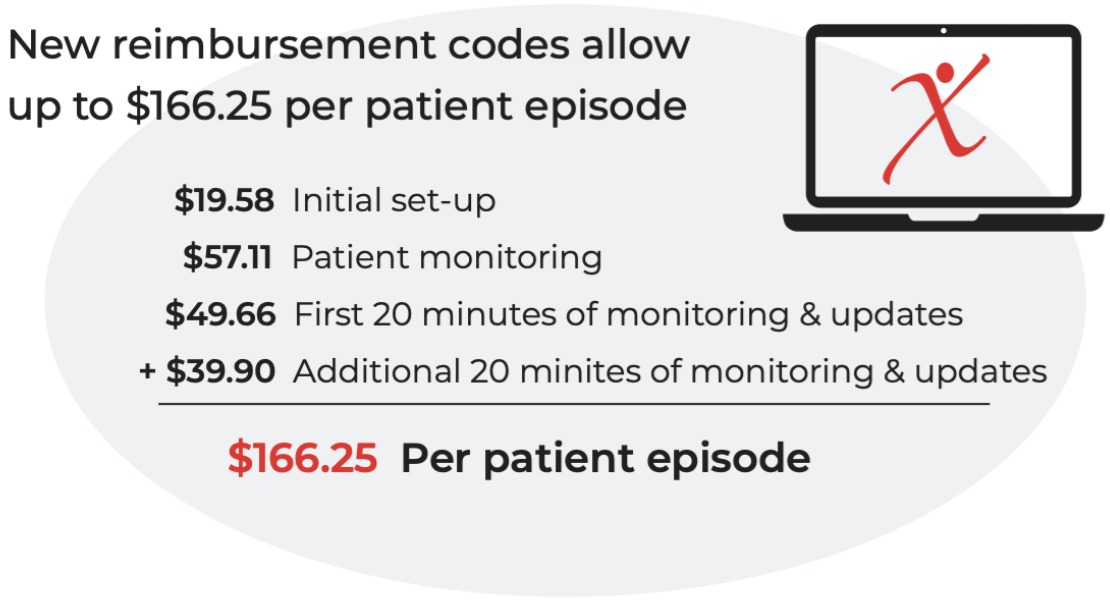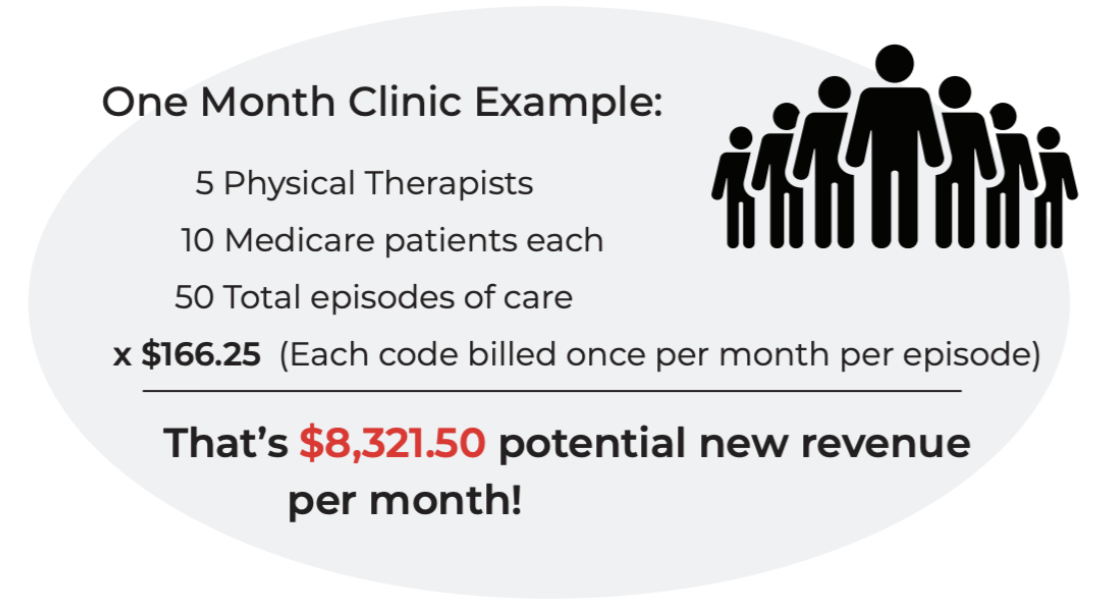With WebExercises’ RTM, your practice will enjoy improved clinical outcomes and increased billings.
What is Remote Therapeutic Monitoring?
Remote Therapeutic Monitoring (“RTM”) is monitoring non-physiologic information, such as medication reminders systems or self-reported patient outcome questionnaires. The billing codes, detailed below, include monitoring the musculoskeletal system, respiratory system status, adherence and response to therapy, pain level and the like.
What is an RTM Episode?
An “Episode” is the period of time from enrolling a patient in RTM to the first to occur of (a) resolution of treatment goals or (b) the revision of the patient’s care plan based on their response to care. The RTM Episode duration is a minimum of 16 days.

Bill an additional $166.25 per patient episode.
WebExercises provides the tools and reporting necessary to meet the requirements for RTM billing.

Who can bill for RTM?
RTM can be billed as general medicine services by physicians and other qualified health providers. Physical therapists (PT), occupational therapists (OT), speech-language pathologists, physician assistants, nurse practitioners, and clinical social workers may also be eligible to bill RTM codes.
What RTM data does WebExercises provide?
WebExercises’ RTM module allows qualifying providers to monitor patient adherence, such as rate of perceived exertion (RPE), compliance with the provider-recommended sets and repetitions, patient self-reported pain levels, and general feedback. Providers can then modify the prescribed program to achieve the best outcomes.
WebExercises’ digital outcome assessment questionnaires for the neck, back and SF-36 health survey are included and can also be assigned to remotely monitor patients. Once submitted by the patient, the questionnaires are automatically scored and support the efficacy of treatment.
FAQs – Remote Therapeutic Monitoring
Is Remote Therapeutic Monitoring covered by insurance?
RTM is covered by most insurance companies and Medicare.
Who can bill for RTM?
RTM can be billed as general medicine services by physicians and other qualified health providers. Physical therapists (PT), occupational therapists (OT), speech-language pathologists, physician assistants, nurse practitioners, and clinical social workers may also be eligible to bill RTM codes.
Can PTA’s or auxiliary staff perform RTM?
Yes. All RTM services may be furnished under CMS’s general supervision requirements which does not require that the physician and clinical staff be in the same building at the same time as the RTM services are furnished. Rather, the billing provider (physical therapist) may bill for services furnished by auxiliary clinical staff under general supervision, provided that the other requirements for “incident to” services are met.
CMS indicates that any clinician who meets the definition of “auxiliary personnel” may serve as auxiliary personnel under the exception. “Auxiliary personnel” is defined as any individual who meets the following criteria:
- Is acting under the supervision of a physician (or another practitioner), regardless of whether the individual is an employee, leased employee, or independent contractor of the physician (or another practitioner) or of the same entity that employs or contracts with the physician (or another practitioner).
- Has not been excluded from Medicare, Medicaid and all other federally funded healthcare programs by the Office of Inspector General or had their Medicare enrollment revoked.
- Meets any applicable requirements to provide incident-to services, including licensure requirements, imposed by the state in which the services are being furnished.
When can the RTM be billed?
The RTM can be billed after an initial 16 days of monitoring, however a minimum of 30 days is required before a new Episode can be set up and billed.
What if the program needs to be updated prior to 30 days?
An exercise program can be updated at any time, based on the patient’s response to care.
What happens if the RTM Home Exercise Program (“HEP”) is cancelled?
Canceling a WebExercises RTM HEP Episode after 24 hours will require a new Episode to be established.
What is the difference between Remote Physiological Monitoring (“RPM”) and Remote Therapeutic Monitoring (“RTM”)?
While Remote Physiological Monitoring uses a medical device that transmits patient information, Remote Therapeutic Monitoring is self reported by the patient through a smartphone app or online platform.
How is the patient’s information collected?
RTM information can be self-reported by the patient. While RTM codes still require that the equipment used fulfill the FDA’s definition of a medical device, Center for Medicare Services (“CMS”) indicates that self-reported RTM data (via a smartphone app or online platform) may qualify for reimbursement.
Does Web Exercises offer training on RTM?
Yes, in addition to an intuitive user interface, Web Exercises provides providers, billers, and clinic staff the education and resources to implement RTM.
Does Web Exercises RTM have a Patient Mobile App?
Yes, Web Exercises provides patients an app for use on both Apple and Android devices.
What is the pricing for Remote Therapeutic Monitoring with Web Exercises?
The pricing for Remote Therapeutic Monitoring with Web Exercises is extremely competitive to get started as well as when billing episodes. To learn more about pricing, contact us today.
How do we get started with Remote Therapeutic Monitoring?
To get started with Remote Therapeutic Monitoring (RTM), the first step is scheduling a demo of the Web Exercises software. Whether you are a physical therapist, chiropractor or allied health professional, you’ll find our RTM solutions intuitive and easy to get started.
4 Steps to Remote Therapeutic Monitoring


